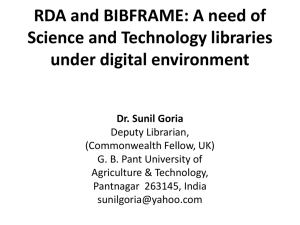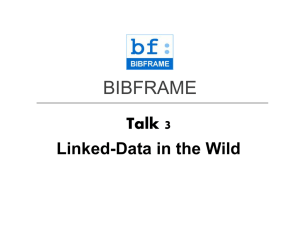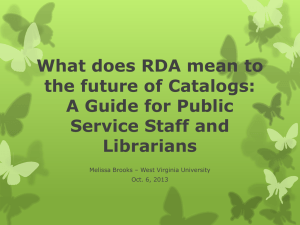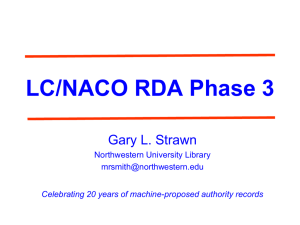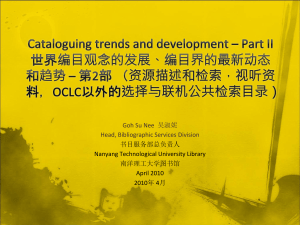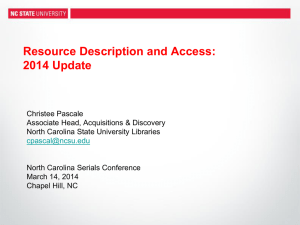RDA_PUG2014
advertisement
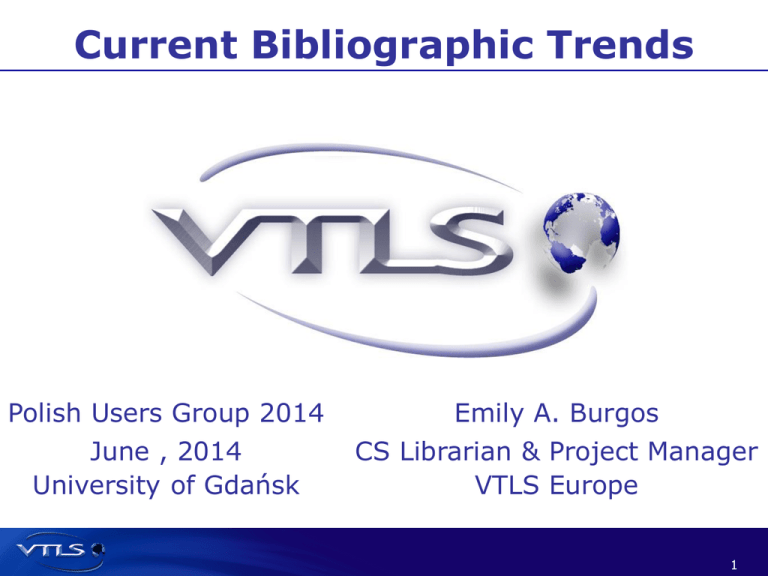
Current Bibliographic Trends 1 Polish Users Group 2014 Emily A. Burgos June , 2014 University of Gdańsk CS Librarian & Project Manager VTLS Europe 1 RDA 2 2 RDA What is RDA? Resource Description and Access Set of cataloging rules Update of AACR2r 3 RDA is independent from the Marc format Based of FRBR and FRAD models 3 RDA Implementation Scenarios Number 3 – Flat file data structure Number 2 – Linked bibliographic and authority records 4 Number 1 – Relational/Object oriented data structure 4 5 5 RDA Why? Simplify the cataloging rules Originally designed to integrate the FRBR model Address current problems with GMD, SMD (limited) Designed for a digital environment 6 International applicability (not only Anglo-American) Not tied to a specific format (Marc21, MarcXML, DubinCore, etc.) Although Marc21 will have to adapt to RDA since it adds new fields 6 Changes for RDA Changes in terminology “Main Entry” is now “Controlled Access Point” Author is “Creator” “see reference” is “variant access point”… “Rule of three” is not used anymore 7 ISBD punctuation is not required, only an option GMD/SMDs are greatly modified. Three new fields are added: 336 (content type) 337 (carrier type) and 338 (media type) “Take what you see and accept what you get” 7 Changes in RDA cont. Bible headings will not include O.T or N.T. but “New Testament” or “Old Testament. Latin abbreviations will be abandoned in favour of natural language phrases: s.l.: Place of publication 8not identified s.n. : Publisher not identified Relator ($e in 100, 110…) is used more often. 264 tag has been added to add more publication information. 8 Special mention Content Type (336) The form of communication through which a work is expressed. Example: text, performed music… Media Type (337) 9 General type of intermediation device required to view, play, run, etc., the content of a resource. Example: audio, video… 9 Special mention Carrier Type (338) Format of the storage medium and housing of a carrier in combination with the media type. Example: audiodisc, videodisc… 10 Example of a book description: 336 $a text $2 rdacontent 337 $a unmediated $2 rdamedia 338 $a volume $2 rdacarrier 10 Special mention Tag 264 Information in field 264 is similar to information 260. Field 264 is useful for cases where the content standard or institutional policies make a distinction between functions (by using 2nd indicator: 0-Production, 111 Publication, 2-Distribution, etc. 11 Changes in RDA Authorities New fields have been added to the authority records: Special coded dates (046 $f) Associated place (370) Address (371) 12 Field of Activity (372) Affiliation (373) 12 Changes in RDA Authorities (cont) New fields have been added to the authority records: Occupation (374) Gender (375) 13 Family information (376) Associated language (377) 13 RDA Scenario One What is it? Linked Records using FRBR model Use of the FRBR entities: Work Expression 14 Manifestation Items/holdings 14 RDA Scenario One Work: Distinct intellectual or artistic creation A Work contains: Preferred title (form of work, dates) Person associated with work (primary, secondary) 15 Notes Subjects (concept, object, event, place…) 15 RDA Scenario One Expression: Intellectual or artistic realization of the work in the form of alpha-numeric notation, music, image, movement, etc. or any combination of such forms An Expression contains: Content Type (336) Language of expression 16 Date of expression Other distinguishing characteristics Person associated with expression Notes 16 RDA Scenario One Manifestation: contains the details on the bibliographic item catalogued: publisher, edition, pages, etc. A Manifestation contains: Title proper Statement of responsibility Edition statement 17 Publication statement Notes Media type (337) Carrier type (338) Items/holdings attached 17 RDA Scenario One 18 18 The “problem” 19 19 FRBR – the solution Work: Harry Potter and the Philosopher’s Stone J.K. Rowling Subject Notes on the work Expression: In French In English In audiobook 20 Notes from the translator Manifestation: Publisher Mondadori Publisher Penguin 3rd Edition Notes from the Publisher Item: Barcode: 587234235 Topográfico: JN Row Notes from that specific item (e.g. donation) 20 FRBR Model Work Work Expression 21 Manifestation Item 21 RDA A work “is realized by” by an expression An expression “is embodied in” a manifestation 22 A manifestation “is exemplified by” an item 22 RDA Let’s see an example in our FRBR database! 23 23 Helpful links RDA Toolkit: http://www.rdatoolkit.org (requires subscription) Joint Steering Committee for Development of RDA: http://www.rda-jsc.org/rda.html 24 RDA in Marc: http://www.loc.gov/marc/RDAinMARC.html LC Training Materials: http://www.loc.gov/catworkshop/RDA%20training%20materials/LC%20RDA%20Traini ng/LC%20RDA%20course%20table.html 24 Bear in mind FRBR can be implemented independently from RDA and RDA can be implemented independently from FRBR, however RDA was designed to be integrated together with the FRBR model. An RDA database can contain FRBR and non-FRBR records 25 VTLS offers scripts to identify and FRBRize those records that can be FRBRized. You can FRBRize and unFRBRize the records in your database at any time. VTLS offers the possibility to create “Superworks” You have the option to revert the FRBR tree 25 Implementation Example Jewish Public Library de Montréal: //catalog.jewishpubliclibrary.org:9011/ Universidad Autónoma de Nuevo León (Mexico): http://uanl.vtlseurope.com/ 26 26 Questions? 27 27 BIBFRAME 28 Polish Users Group 2014 Emily A. Burgos June , 2014 Gdansk, Poland CS Librarian & Project Manager VTLS Europe 28 BIBFRAME BIBFRAME Initiative is: The future of bibliographic description the web networked world To integrate with and engage in the wider information comunity (not only libraries) 29 http://www.loc.gov/bibframe/ http://bibframe.org/ 29 BIBFRAME BIBFRAME Initiative tries to: Differentiate clearly between conceptual content and its physical/digital manifestation(s) Unambiguously identify information entities (e.g., authorities) Expose relationships between and among entities Create a new way to represent and exchange bibliographic 30 data – that is, replace the Machine Readable Cataloging (MARC) format But the scope is broader 30 BIBFRAME Contracted with Zepheira the development of the model (May 2012) Also Zepheira’s tasks: Develop prototype services and tools to enable experimentation Create a roadmap for moving forward toward refinement, 31 redevelopment, or alternative approaches https://zepheira.com/ Early experimentation started Oct-Nov 2012 31 BIBFRAME BIBFRAME Model: conceptual/practical model For detailed bibliographic description, For other cultural materials, For those who do not require such a detailed level of description. 32 There are four high-level classes, or entities, in the BIBFRAME Model: Work, Instance Authority Annotation 32 BIBFRAME BIBFRAME Model Elements: Work: identifies the conceptual essence of something Instance: reflects the material embodiment of a Work Authority: identifies a thing or concept associated with a BIBFRAME Work or Instance 33 Annotation. provides a new way to expand the description of a BIBFRAME Work, Instance, or Authority 33 BIBFRAME 34 34 BIBFRAME BIBFRAME Model Vocabulary Key to the description of resources. Defined set of classes and properties. A class identifies a type of BIBFRAME resource (like a MARC field might bundle a single concept); properties serve a means to further describe a BIBFRAME resource 35 (much like MARC subfields more specifically identify aspects of the concept) http://bibframe.org/vocab/ 35 BIBFRAME Difference between MARC and BIBFRAME MARC bundles everything neatly as a record and duplicates information accros multiple records The BIBFRAME Model relies on relationships between resources (W2W, W2I, W2A…) and the use of controlled identifiers for things (VIAF, etc.) 36 MARC employs these ideas already but BIBFRAME seeks to make these aspects the norm rather than the exception Ultimate goal: make BIBFRAME the entry point to a web of data 36 BIBFRAME Is it ready yet? No, the model and its components is still in discussion and development Tool to convert MARC to BIBFRAME http://bibframe.org/tools/ (example: 9698343) 37 Expectation: we will have dual systems for a long time Early Experimenters British Library, George Washington University, Princeton University, Deutsche National Bibliothek, National Library of Medicine, OCLC, and the Library of Congress. 37 BIBFRAME They are looking to increase their groups of implementers right now. Testbed: http://www.loc.gov/bibframe/implementation/testbed.html BIBFRAME listserv 38 Example of the German National Library https://portal.dnb.de/opac.htm?query=lady+of+secret+devotion &method=simpleSearch Recommended reading: http://www.loc.gov/bibframe/pdf/marcldreport-11-21-2012.pdf 38 BIBFRAME Requirements to implement BIBFRAME Ability to support linked records Ability to support the BibFRAME data model Ability to support BibFrame records and traditional MARC records. XML and Marc need to coexist (MMS) Ability to display hierarchic records (like FRBR) 39 A navigation and visualization system that allows users to see the links between entities and navigate them. 39 BIBFRAME VTLS linked data implementations VTLS has four implementations using linked data FRBR – implemented at several locations ISAD – International Standard Archival Data RDA – using FRBR model BibFrame – using ISAD model (in progress) 40 40 BIBFRAME WHY ISAD? FRBR is too rigid Only four levels Items can be attached only to lowest level Cannot skip levels ISAD hierarchy is very flexible 41 As many levels as you like …. This allows for easy changes if required in the future Items can be attached to any level Can skip levels if required Flexibility is important as BIBFRAME is still evolving 41 BIBFRAME Example 42 42 BIBFRAME Zoom-in view 43 43 BIBFRAME BIBFRAME view 44 44 BIBFRAME Viewing an instance record 45 45 BIBFRAME Viewing an annotation linked to an instance 46 46 BIBFRAME Linked Data Visualization 47 47


